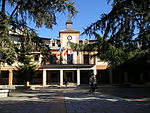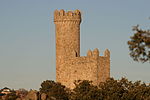La Ciudad del Fútbol
2003 establishments in SpainAssociation football training grounds in SpainBuildings and structures in the Community of MadridFootball academies in SpainLas Rozas de Madrid ... and 3 more
National football academiesRoyal Spanish Football FederationSports venues completed in 2003

Officially La Ciudad del Fútbol de la Real Federación Española de Fútbol (English: The Football City of the Royal Spanish Football Federation) is a football training facility opened in 2003, serving as the headquarters of the Royal Spanish Football Federation as well as the official training centre of the Spanish football team. It is located in the municipality of Las Rozas de Madrid around 20 km northwest of the capital Madrid, within the Community of Madrid.
Excerpt from the Wikipedia article La Ciudad del Fútbol (License: CC BY-SA 3.0, Authors, Images).La Ciudad del Fútbol
Avenida de Esparta,
Geographical coordinates (GPS) Address Nearby Places Show on map
Geographical coordinates (GPS)
| Latitude | Longitude |
|---|---|
| N 40.524 ° | E -3.901 ° |
Address
Ciudad del Fútbol de Las Rozas
Avenida de Esparta
28232 , La Dehesa
Community of Madrid, Spain
Open on Google Maps









